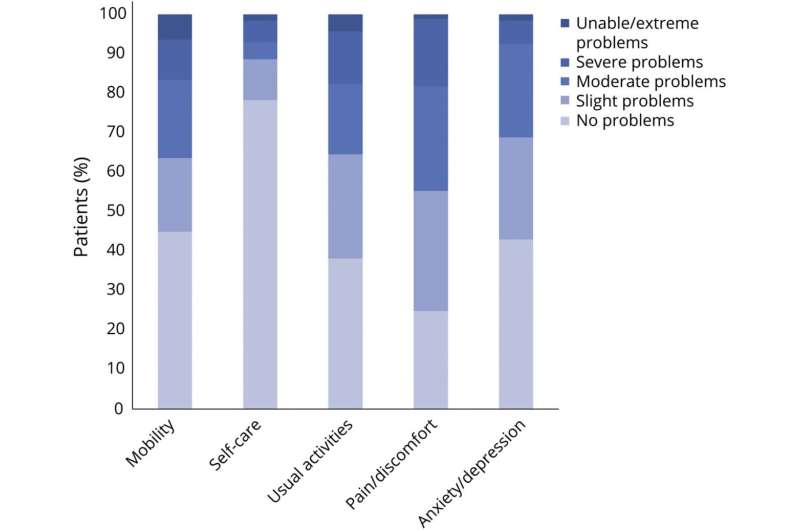This article has been reviewed according to Science X's editorial process and policies. Editors have highlighted the following attributes while ensuring the content's credibility:
fact-checked
proofread
Effects of the COVID-19 pandemic on patients with NMO spectrum disorders and MOG-antibody-associated diseases

In times of crisis, it is advantageous for people with rare diseases to receive care in highly specialized centers. This is underlined by an MHH study. It shows that the people with the autoimmune diseases NMOSD and MOGAD cared for there came through the COVID 19 pandemic well.
For people with chronic diseases, the COVID-19 pandemic was particularly challenging: many were worried and uncertain about the risk of infection, vaccination, and continuing their (immunosuppressive) therapy. A team from the Department of Neurology with Clinical Neurophysiology at Hannover Medical School (MHH) wanted to know how patients with the rare chronic autoimmune diseases neuromyelitis optica spectrum disease (NMOSD) and myelin oligodendrocyte glycoprotein antibody-associated disease (MOGAD) got through the pandemic.
Therefore, they conducted the "Effects of the COVID-19 Pandemic on Patients with NMO Spectrum Disorders and MOG-Antibody-Associated Diseases" study—COPANMO(G) study for short. The result: during the pandemic period, both medical care and care satisfaction and health-related quality of life were stable. The study was published in the journal Neurology—Neuroimmunology Neuroinflammation.
Severe physical limitations
NMOSD and MOGAD are rare autoimmune diseases that, like multiple sclerosis (MS), usually cause relapsing inflammation of the central nervous system (CNS). Those affected suffer from sometimes severe physical limitations such as visual impairment, paralysis, incontinence and pain. In Germany, there are an estimated 4,000 people with the diseases.
"In this study, conducted at 19 German and Austrian centers, we examined in detail the effects of the COVID-19 pandemic on sufferers with NMOSD and MOGAD," explains Dr. Martin Hümmert of the MHH Department of Neurology. He led the study together with Professor Dr. Corinna Trebst, deputy director of the clinic.
Together with doctoral student Franziska Bütow, they wanted to gain insights into medical care and the quality of life of those affected on the one hand, and on the other hand they were interested in the courses of SARS-CoV-2 infections as well as after vaccinations against SARS-CoV-2 and the possibly associated effects on the underlying disease.
Therapies were continued
The questionnaire study involved 187 patients receiving care at a specialized treatment center run by the Neuromyelitis Optica Study Group (NEMOS, www.nemos-net.de). "In summary, we can state that it is a great advantage for patients with a rare disease such as NMOSD or MOGAD to be connected to a specialized center in pandemic times," says Professor Dr. Trebst.
In fact, 91 percent of respondents said they had been satisfied with their overall medical care. A majority of 89 percent had kept their doctor's appointments as usual; therapies such as physiotherapy, speech therapy and occupational therapy had also mostly continued unchanged. Immunotherapies also remained unchanged for 88 percent of patients despite the pandemic.
High willingness to vaccinate
Two-thirds of those participating in the study rated their risk of infection as low to moderate. "This does not mean that their risk of infection is actually low; rather, it shows that they were probably particularly cautious," explains Franziska Bütow. Only twelve percent reported having passed through a SARS-CoV-2 infection, which was mostly mild. The vaccination rate of the patients was very high: 89 percent were fully vaccinated against SARS-CoV-2.
The authors of the study attribute the high rate of vaccination in part to extensive counseling at the specialized treatment centers. The most common reason for reluctance to vaccinate was fear of side effects and negative impact on disease. In four cases, there was a temporal relationship between vaccination and the initial manifestation of disease or a disease flare.
"Further studies are certainly needed here to clarify whether vaccination really has a causal relationship," says Professor Trebst. So far, she says, this connection cannot be established. "The results of a large British study show that there is rather no increased risk for the occurrence of neurological autoimmune diseases after SARS-CoV-2 vaccination, but there is after infection with SARS-CoV-2," adds Dr. Hümmert.
In terms of quality of life, more than half of the patients surveyed reported mild to extreme problems in the following areas: Mobility, usual activities, anxiety/depression, pain/physical discomfort. Nevertheless, the scores related to the pandemic period were overall not worse than before the pandemic. Health-related quality of life was stable or even improved.
More information: Martin W. Hümmert et al, Effects of the COVID-19 Pandemic on Patients With NMO Spectrum Disorders and MOG-Antibody–Associated Diseases, Neurology—Neuroimmunology Neuroinflammation (2023). DOI: 10.1212/NXI.0000000000200082

















